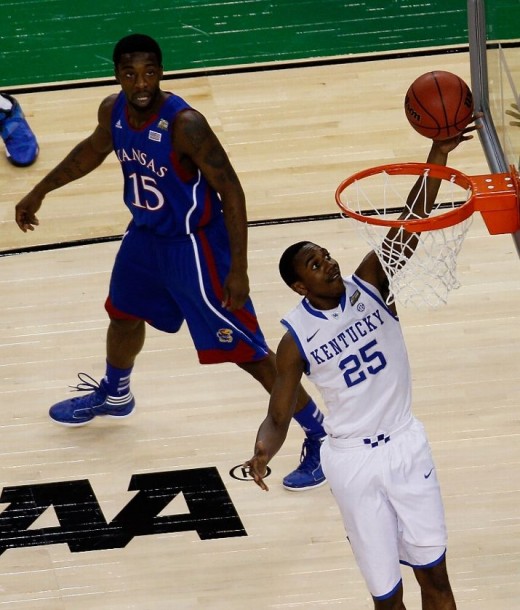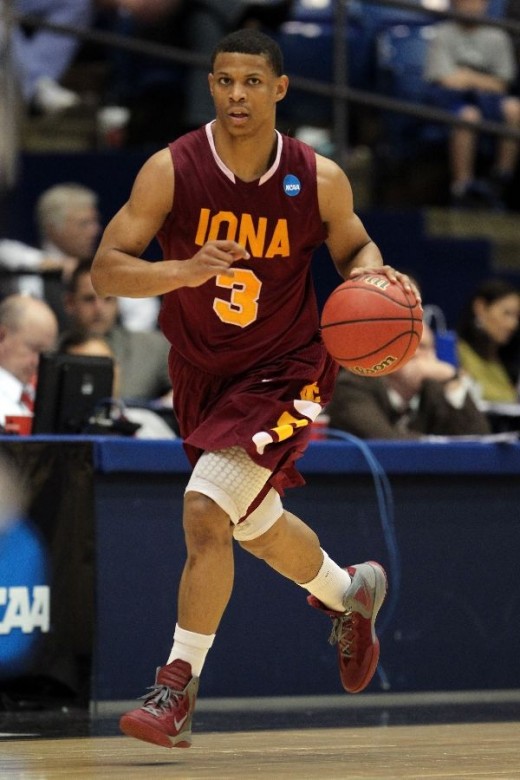Draft Profile: Marquis Teague and Scott Machado
2012-06-07Today, let’s look at the position that Cavs fans love to ignore. Kentucky’s Marquis Teague generally falls as a late first round pick, while Iona’s Scott Machado ranks in the first half of the second round. I know there’s no chance that Cleveland takes a point guard at #24, but what’s a series of draft profiles without the sixth member of Kentucky’s national champs? Oh, and if Cleveland chooses to look for Kyrie’s backup at #34, Scott Machado may be right in their wheelhouse.
Athletically, Teague meets all the criteria for an NBA floor general: 6’ – 2” tall, 6’ – 7” wingspan, fast, and explosive – he checks all the boxes. Speed serves as his most elite trait, as he cruises around at warp pace, capably keeping the ball on a string. His best work comes in transition, both attacking the basket and finding cutting wingmen or open shooters. Struggles in the half-court result due to excessive dribbling, forced passes, and a frequently errant jump shot; overall his efficiency is poor, with true shooting of 49% ranking 37th of 44 qualified SEC players. He converted only 32% of his threes. While he could certainly improve on his 2.7 turnovers per game, the corresponding 4.8 assists provide a respectable ratio for a freshman. On defense, his size, speed and aggressiveness provide the tools to be an excellent contributor at that end.
With nearly ten per game, Machado lead the NCAA in assists last season. As a 6’ – 1” tall senior, he posted 13.6 points on exceptional 50 / 40 / 81 shooting. His “pure point rating” calculates as the second best of all prospects in draftexpress’s database for the last ten years, behind Kendall Marshall. Marginal as an athlete; his leaping and agility tested below average at the New Jersey draft combine. These flaws mostly manifest themselves on defense, where combined with his small size, they cause problems staying between his man and the basket. As a quick point guard with deep shooting range and elite court vision, NBA teams searching for a “one” will surely look closely as the draft approaches.
Game Recaps: In UK’s final four victory over Louisville, Teague tallied 8 points, 5 assists and 2 turnovers on 50% true shooting. Offensively, his damage came in transition, through the pick-and-roll, and from isolation, as he gathered buckets & assists from each set. His speed looked great, including controlled coast-to-coast gallops, where he forced a few non-shooting fouls. Two assists came via drive-and-kicks and two via no-look transition dishes. On defense, it was a tale of two halfs. For the first twenty minutes, he played the best point guard defense of this year’s prospects; attentive and quick, keeping U of L’s guards from penetrating and tying up big men on double-teams. In the second half, perhaps he winded, as the opposing ball-handlers breezed by him on several plays and he limped through picks.
Machado netted 24 points on 71% field goal shooting to go with 7 assists in Iona’s 75 to 85 conference tourney loss to Fairfield. His best work came from the perimeter, producing 12 points on 7 shots, including shots out to NBA long-ball range. Less effective at the basket; besides the six points scored during the last minute of garbage time, he procured only 6 points on 9 plays. Several isolation forays resulted in blocked shots or wild tosses at the hoop. He threw several nice passes, including two drive & kicks for corner threes and a beautiful cross-court transition dime from at least thirty feet out. An odd aspect of the game included Machado receiving credit for three assists in the first four minutes though. When the announcers mentioned this, I needed to check the play-by-play and rewind. Two included passes to players at least eighteen feet from the basket, one technically a hand-off, then the player drove for a score at the basket. To me, those aren’t assists, and I’ll assume Iona’s score keeper is not always that friendly. Defensively he disappointed, frequently lit up by his opposing number in isolation and struggling through screens.
I watched this Iona game, because it was the only one available on ESPN3. Obviously an efficient 24 & 7 looks pretty good in the box score and has it’s highlights, but as described, much of his work proved non-inspiring. Maybe he battled some off-court drama on March 4th. Draftexpress tweeted twice during the game, both negative, once saying “Scott Machado totally MIA here. Not talking or trying to show any leadership. Passive body language. No emotion. Very disappointing stuff.” Anyways, it goes to show that even an efficient twenty-four points does not always mean dominance.
Summary: I like Teague. From February to the end of the season (17 games), he scored 10.3 points on 50% true shooting with 5.3 assists and 2.5 turnovers. All marks better than the first half of the season, and his distributing numbers jumped very nicely against a schedule that included Florida and Vanderbilt three times each, plus the NCAA tournament. He’s really fast, plus as a teenager, he lead the NCAA champs in minutes played. I’m not sure what else people expect from eighteen-year-olds on a big stage (not everyone can be Kyrie-fricking-Irving!). I foresee steady improvement in his shooting and decision making, and a nice NBA career. The close-constraints of the NCAA game, combined with the fact that four of UK’s starters combined to shoot 29% from three, lead to a lot of paint-packing-defenses and tough driving conditions for Teague. The more open pro-game serves Teague very well. My inclination is he won’t last until #26, but ESPN’s mock draft 5.0 included selection by his hometown Pacers. It’s not NBA championship material, but adding Teague to 22-year old Paul George builds a strong backcourt foundation for many years.
Steve Nash played for a mid-major college and was too small, not athletic enough, etc. Of course, he developed into one of the NBA’s all-time great point guards. Do I think the same will happen with Scott Machado? Of course not…that would be stupid. Should the Cavs consider drafting the Iona Senior at #34, instead of mowing through a season’s worth of D-League all-stars at back-up point guard? That seems like a reasonably defensible decision.



If He’s there at 33 I think we should draft Kyle O’Quinn and forget Melo. O,Quinn is a Beast and we need offense
If we pick a pg in the draft my money would be on Jared Cunningham out of Oregon St. I love TRob’s attitude challenging Davis every chance he gets. If he’s there at 4 which I doubt I say pick him. I know we have TT but we need a big that can score and Robinson will be the best player on the board once Davis is gone
http://nbadraft.net/tale-tape-combine-measurements-analysis
Interesting numbers here. John Jenkins stands out as a possibility at 24, as well as the beastly Andrew Nicholson (Darft Express now has him going to the Cavs, and some now have him in the top 20). Jae Crowder redeemed himself a little, and might make a decent 2nd rounder. If we trade up or down to 10, Myers Leonard might be very interesting (or he could be this year’s Joe Alexander).
I like Machado’s numbers a lot, but I don’t think he’s a great fit for the cavs. A backup point guard that is a lousy defender isn’t what the Cavs need. They should either get a guy who can play combo guard and/or someone who can play some defense. I like Zack Rosen as an undrafted free agent, if we can get him. http://www.draftexpress.com/profile/Zack-Rosen-17930/
And I’d like to add one thing I heard about Andre Drummond while watching the combine. One of the ESPN hosts, I’m not sure which one, said he had previously asked Drummond what player he compares himself to, and his answer was KD- Kevin Durant!! Not KG (or KJ for that matter) but best in the league, range out to 30ft Kevin Durant! We shouldn’t touch anyone that delusional with a 39 1/2 foot pole.
We need a backup PG but couldn’t a healthy Gibson fill that role well enough? Amongst the best backups in the league, you could say only Mo Williams is backing up a star PG. The majority of good backups are nearly equal to their starting counterparts (see Lou Williams, Darren Collison, Andre Miller, even JJ Barea), which means they end up playing large minutes. If we really do have a star in Kyrie, we don’t need a really good backup. The Thunder have Derek Fisher, the Celtics have Keyon Dooling, the Bulls have CJ Watson, and the Spurs have Gary… Read more »
They still need a quality backup PG. Don’t forget that the second unit had a more difficult time scoring once Sessions was traded. I’d rather see them draft Tyshawn Taylor, but Machado would make sense. As Kevin said, it’s doubtful Teague would be available. Of course, that’s if the Cavs keep picks 33 & 34. I think it’s possible they package them in a trade.
I don’t think the Cavs should avoid PG’s in the draft just because they’re set with Kyrie. The Cavs should be looking at whoever the best players available are (that are compatible with the team); they’re so devoid of NBA talent that drafting for positional need is not really a luxury the Cavs have in most cases.
I totally agree, “reaching” for a PG somewhere in the draft is better than mowing through a whole lawn’s worth of D-Leaguers all season… gas is expensive
I didn’t like Teague this year, although that’s partially because I was expecting him to play like a top 5 freshman as his ranking suggested. You can definitely see similarities between him and his brother. Teague is fast, but finishes below the rim. I felt like over half of his assists were alley-oops to Davis or Jones. His range is mediocre and ultimately, I was unimpressed. However, with his natural athleticism, he’ll be good enough to have a career very similar to his brother’s: best backup PG in the league or below average starter. As far as PGs in general,… Read more »
AlexS,
I think the younger Teague will be a bit better than his brother.
I don’t disagree with the idea of not drafting a PG this year, but if the Cavs really like one and pick him at #34, that would be fine. Maybe they end up with the new Mark Price (except Irving is better) / Kevin Johnson, then trade KJ2012 for a big in a few years.